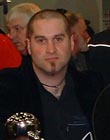|
|
This topic comprises 2 pages: 1 2
|
|
Author
|
Topic: Kinoton Dual Basement Reader Question
|
|
|
|
|
|
|
|
|
|
|
|
|
|
|
|
|
|
|
|
|
Steve Guttag
We forgot the crackers Gromit!!!

Posts: 12814
From: Annapolis, MD
Registered: Dec 1999
|
 posted 08-02-2014 07:58 AM
posted 08-02-2014 07:58 AM




Some basics here...
A true differential output needs no ground reference. Think transformer...it need not be center-tapped to ground for it to work (balanced)...it merely provides the potential difference.
Its noise immunity comes from that it is a differential signal such that if the input is also differential, you have a high common mode rejection since anything that hits both wires (why they are twisted) will be of equal potential on both wires and will be rejected since they are not differential.
You'll find that the common terminal on both outputs of that board, like Kelmars (I think that it is a stock Dolby board, like the Dolby Digital reader board...it sure looks like the Kelmar board) is the same. You can't really call it a ground because there isn't really a ground reference to it. It should be at the signal reference potential. The wire Kinoton has going to it is a shield wire. A valid way but not my preferred way.
Ideally, one should use shielded wire but NOT terminate it at the cell end. The cell end has no reliable ground reference in a film projector (this is true for most every film projector throughout their history). As such, it has no draining ability for the screen of the cable. Ideally, you DO want the cell end to be floating anyway because you WANT it to be at the same reference potential to your sound system. This will avoid hums/noises from "Ground loops." Prior to the reverse reader craze, the solar cells did a nice job of not providing any ground reference.
You want the cell wire to have its screen tied to a good ground to be effective and that is best done at the sound processor end where there is likely a good earth if the system was installed properly.
Now since these are not transformer isolated systems and are electrically balanced, there is going to be that reference terminal on the cell board...what is best is to run a dedicated wire of reasonable size (the further away from the sound head, the larger the gauge) to bring the cell board to the same potential as the sound processor. You want ZERO current flow on the ground reference.
I can tell you with many successful installations with Kinoton that you will achieve your quietest optical systems in this manner.
Note too, the part of the system you are looking at in your picture goes to a terminal strip mere centimeters away. The fact that they are using the shield as both a shield and reference is of no consequence. There is NO way that one channel is noisier than the other due to how this is wired.
The reference power for both channels is the same and thus both channels share the same reference so the two terminals are identical. I'm sure the design of the board is for those that would make home-runs from each channel using 2-cond/screened cable so that the screens from each channel could be tied at the board. It is a common practice though it is not one that I, personally, recommend for the reasons listed above.
| IP: Logged
|
|
|
|
|
|
|
|
|
|
|
|
All times are Central (GMT -6:00)
|
This topic comprises 2 pages: 1 2
|
Powered by Infopop Corporation
UBB.classicTM
6.3.1.2
The Film-Tech Forums are designed for various members related to the cinema industry to express their opinions, viewpoints and testimonials on various products, services and events based upon speculation, personal knowledge and factual information through use, therefore all views represented here allow no liability upon the publishers of this web site and the owners of said views assume no liability for any ill will resulting from these postings. The posts made here are for educational as well as entertainment purposes and as such anyone viewing this portion of the website must accept these views as statements of the author of that opinion
and agrees to release the authors from any and all liability.
|

 Home
Home
 Products
Products
 Store
Store
 Forum
Forum
 Warehouse
Warehouse
 Contact Us
Contact Us




 Printer-friendly view of this topic
Printer-friendly view of this topic













